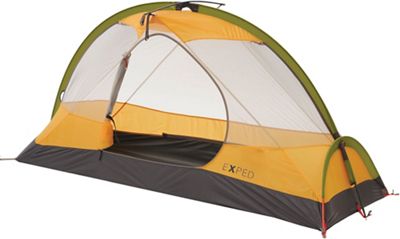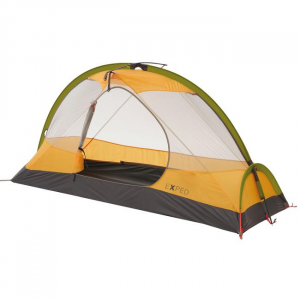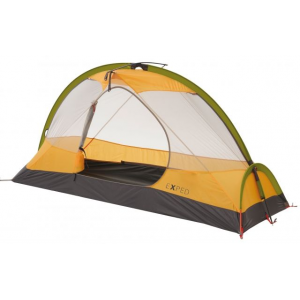
The Exped Mira HL 1 is a surprisingly lightweight and comfortable one person tent weighing just 35 oz. It has two vestibules, one for gear storage, and a second for easy access and exit. A long arched ridge-pole provides lots of head room, making it easy to change clothes and move around inside the tent. Color-coded tent poles and a clip-on rain fly make set up easy, while the inner tent's mesh netting provides excellent ventilation and insect protection.
Specs at a Glance
- Min Weight
- Fly: 11.55 oz
- Inner: 12.9 oz
- Poles: 10.4 oz
- Size: 1 person
- Type: Double-wall
- Inner Tent Dimensions: 83″ (length) x 26″ (head and foot ends) x 39″ (height)
- Poles: 3
- Max pole segment length: 16″
- Minimum stakes to pitch: 6
- Materials:
- Fly: 20 D ripstop nylon, silicone-/PU coated, factory seam taped, 1500 mm water column
- Floor: 20 D ripstop nylon, laminated, factory seam taped 1500 mm water column
- Canopy: 15 D ripstop nylon, 15 D No-See-Um mosquito mesh nylon
- Footprint: Available
The Exped Mira 1 HL Tent is a one person, double-wall tent that than can fit into narrow spaces, making it ideal for forested pitches or anywhere where there's not a lot of room to set up a tent. It's designed to be highly livable, with lots of head room, interior room to change and move around in, and covered storage space that doesn't interfere with the tent's entrance.
Tent Pole architecture
The Mira 1 has three tent poles: a long ridge pole that spans the length of the inner tent, a horizontal pole positioned at the head end of the tent to create more head room, and a second horizontal pole that is use to maintain the width of the inner tent closer to the ceiling. The first two poles slide into sleeves sewn into the inner tent and slot into grommets in the tents guy-out points.

Poles sleeves are a common feature on many tents made by European tent manufacturers. While they make setting up and taking down a little more involved than the clips used by American tent manufacturers to attach inner tent bodies to poles, they produce a much stronger tent structure, one where the inner tent isn't as buffeted by winds. Some manufacturers even let you slide a second pole into the sleeve, to increase the tent's strength to counter extreme winds or heavy snow loads.
While having three separate poles makes setting up the Mira's inner tent a little more complicated, you quickly get the hang of it after doing in a few times. The poles are color coded which helps, although you need to be careful when you break down the tent to make sure you pack all of them away. If there's an advantage to the interconnected, hubbed poles you find on tents made by US tent manufacturers, it's that they're much harder to misplace or lose.
The Mira 1's inner tent requires a minimum of four stakes (in the corners) to set up, while the fly requires a minimum of two. The fly connects to the four corners of the inner tent with colored coded clips, which makes it very fast to deploy, a good thing if its raining, since this is a double wall tent. There aren't any extra guy-out points along the top of the ridge line or vestibules however, which could be used to make the tent more wind resistant in a gale.

Dual Vestibules
The resulting structure is a one person tent with two vestibules, a large front vestibule and a narrower rear one for gear storage. The rear vestibule is best though of as a gear closet rather than a full vestibule. It is about as deep as a full backpack and can be accessed from the inner tent with a zipper that runs horizontally atop the bathtub floor, so rain can't leak into the inner tent. The opening isn't big enough to pass a fully loaded backpack through, so it's best to lift up the rear rain fly and pop the pack in from that direction. However, once under cover, there's plenty of room to remove items from the pack or put them away for safekeeping. The rear vestibule area is also a great place to store your shoes/boots or other wet items, so that don't leak over your dry gear.
The front vestibule is positioned on the long side of the tent, so you can use half of the tent width for more gear storage without blocking access. This vestibule has a two-way zipper, so you can vent the tent from the top or the bottom without fully opening it. There's also a flap over the top of the zipper so you're not drenched when you open it in the rain
Interior livability
The interior of the Mira 1 is spacious for a one person tent. It has a truly rectangular bathtub floor that does not taper from head to foot, so you can use a rectangular sleeping pad instead of a mummy shaped one (the tent is compatible with Exped M and LW sized pads). The inner tent has one side pocket inside for gear storage and numerous gear loops so you can hang items or lighting from the ceiling. There is also an abundant amount of mesh for ventilation as well as solid breathable panels for extra privacy.
The long arched ridge pole maximizes headroom overhead, so you can sit up and change comfortably in the tent. This is relatively rare in most one person tents, which have slightly more head room than a bivy sack. For example, I can kneel on an inflatable sleeping pad inside the Mira 1 HL, which isn't something I can do in a lot of the other one person tents I use regularly. The added height also makes getting in and out if the front vestibule easier, without having to crawl on your belly to enter or exit the tent.

Recommendation
The Exped Mira 1 HL is a comfortable one person tent that's well suited for three season weather. While it is narrow enough to fit into tight spaces, the interior of the tent has spacious dimensions with vertical side walls and a high ceiling so you can sit up and move around easily inside. Livability is further enhanced by the rear gear closet and front vestibule which provide additional gear storage space and ease of access. The near-freestanding inner tent (staking is still recommended) can also be used as a standalone screen shelter in mild and dry weather. Weighing 2 lbs and 3 oz, the Mira 1, provides a good balance between light weight and durability.
Compare 4 Prices
Disclosure: Exped provided the author with a sample tent for this review.
Help support this site by making your next gear purchase through one of the links above. Click a link, buy what you need, and the seller will contribute a portion of the purchase price to support SectionHiker's unsponsored gear reviews, articles, and hiking guides.The post Exped Mira 1 HL Tent Review appeared first on Section Hikers Backpacking Blog.
from Section Hikers Backpacking Blog https://ift.tt/2OhbwIt








No comments:
Post a Comment